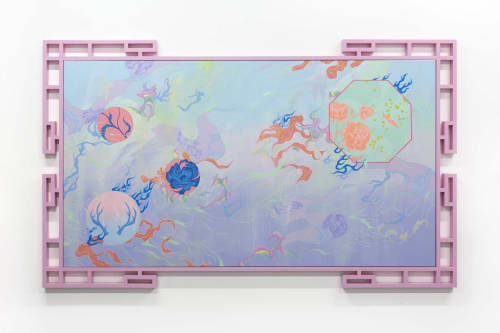LOUISE ZHANG'S ART IS INSPIRED BY HORROR MOVIES, DEMONS AND CHINESE MYTHOLOGY.
Hi Louise! Can you sum up your artistic style in three words?
Saturated, curious, conflicted.
What were your early experiences with art like? As a kid, I didn't have much of an opportunity to participate in many extracurricular activities. In a sense, I had to raise myself while my parents worked to keep me in school, so I had the opportunity to spend time with my imagination. One of the things really enjoyed was turning one of my shelves into a little shop: Louise's Corner Shop. I would make ‘groceries’ (mostly chicken nuggets) using marker and tissues.
What ongoing fascinations from childhood have stayed with you?
I absolutely loved fantasy, magic, and any form of ‘candy land’ aesthetic. I loved Sabrina The Teenage Witch, and Doraemon dubbed in Mandarin. Then one day I found Charmed - I was hooked - and that led me to Tim Burton. I became an emo (well, a Christian emo) and found likeminded people online and finally felt like I fitted in. I got into body horror because it felt like such a visceral schism to my upbringing - these subjects were taboo and were derided by my Chinese Christian community as being sources or anxiety and depression.
Is it true that flourishes in your paintings are guts?
Yes, it’s true, but it’s a combination of non-gut imagery mixed in with some guy imagery. Some of my favourite reference books are anatomy ones. But there are heaps of guts in cartoons that inspire me, too.
Which horror films have inspired your work?
The Fly (1986), Repulsion (1965), and SpongeBob SquarePants (if you check out all the Gross-Up Close-Up scenes made popular by The Ren & Stimpy Show, it’s essentially a body horror series). I’ve always loved things that were just a little off – that curiosity when you’re confronted with something gross. You know it’s there, you know it’s disgusting, but you have something nudging you saying, ‘Just take a peek. You know you want to!’
Why do you choose to paint with bright colours?
I’ve realised that I’m drawn to these colours because they can be so saccharine. Colour is a powerful manipulation tool; it’s similar to marketing. It can transform meaning (for example, I could paint a bloody organ in red and browns and all those familiar flesh tones, but instead, I paint it in pastels and rainbow tones, it completely shifts our perceptions, even though it’s still a bloody organ). Certain colours draw you in – even if they repulse you, they catch your attention. I want audiences to take the opportunity to look deeper into my work. I use colour as a form of comfort to talk about things that are not so comfortable.
Tell us a bit about your process.
With paintings, I do a sketch on paper, the canvas or on a tablet. From there I either freehand or project onto the canvas. Once I've mapped out the basics, I just dive in and make it up as I go. The one consistent thing I do for paintings is take time to think about what I would like to say and how I can say it, without depicting a traditional narrative. I'm drawn to symbols, motifs, and euphemisms, because although they come from a specific personal space, it also can mean many other things for other people.

